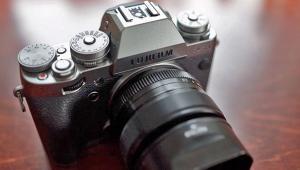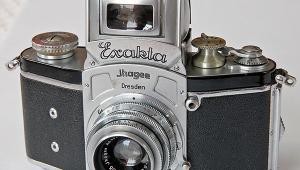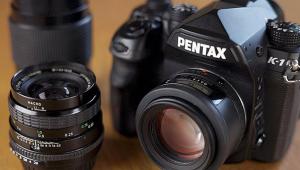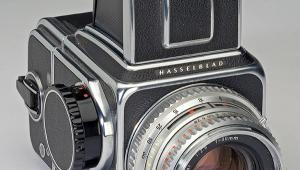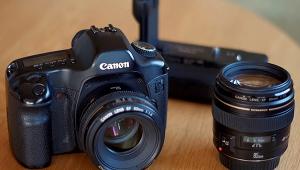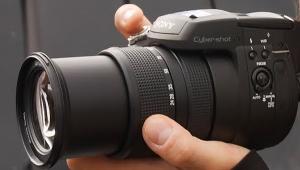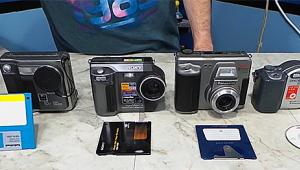Werra; An East German Wonder
The Germans notoriously have a word for the guilty pleasure of enjoying another’s misfortune or embarrassment: Schadenfreude. If you want a small hit of this reprehensible amusement, hand a fellow photographer a Werra (with the shutter ready cocked) and ask them how they like it. Tell them there’s no film in it; tell them to try the action. They’ll probably look through it; press the release; and then indulge in a lively game of hunt the advance mechanism.
 |
|
|
Werras are compact, impossibly elegant cameras made in the old East Germany by the original Zeiss Jena works, after the rest of the company moved to Oberkochen. The majority were made in the 1950s, before communism ground the workers down too far, so they are classic, surprisingly well-made cameras.
There are numerous models. The original flat-topped version had a fixed scale-focusing lens, but somewhat like Maurice Chevalier’s little girls, Werras grew up in the most delightful way, acquiring (as options) rangefinders, exposure meters, interchangeable lenses, a curvy top, and extremely good looks in the process. Broadly, they fall into six groups.
The Werra 1 is the basic model: no rangefinder, no meter. The Werra 2 has an uncoupled meter in the top plate but no rangefinder; the 3 has a coupled rangefinder but no meter; the 4 and 5 each have a rangefinder and uncoupled meter; the Werramat is a 1 with a coupled meter and read-out in the viewfinder; and the Werramatic is a 3 with a ’Mat-style meter. Early models had different top plates; late models (like the one illustrated here) used a common top plate with a removable front window to allow several configurations with the same top plate.
All are tiny. My Werra 3 is just 115mm wide (41⁄2”, not counting strap lugs), 83mm front-to-back (31⁄3”, with the lens cap on—75mm/3” without), and 83mm high (31⁄3” again, including the accessory shoe). Even so, it is pleasingly solid in the hand: 400g, 14 oz.
And they are…well…strange. First, that advance mechanism. It’s a collar around the lens. Twist it 45? clockwise and you wind on the film and cock the shutter.
Ah, yes: the shutter. First you have to find it, lurking under the reversed lens hood. Unscrew the hood; reverse it; screw it into the front of the lens; and there’s your lens shade as well as access to the controls on the Prestor RVS shutter, speeded from 1 second to 1/750 sec plus B. There are the usual steps from 1 second to 250 sec, then 1/750 sec. This very high top speed is obtained via an unusual design using rotating shutter leaves. Conventional leaves open; reverse their motion; then close. These simply rotate without reversing. This necessitates a second pair of capping blades for when the shutter is being cocked. Despite its complexity, the Prestor RVS is extremely reliable; mine still works without demur at all speeds.
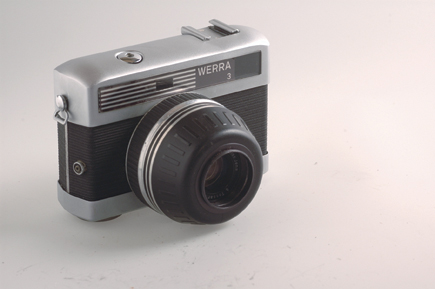 |
|
|
Alas, it uses a variation on the poisonous Light Value (LV) system, where shutter speeds and diaphragm settings are interlinked: go (say) from 1⁄30 to 1⁄60 sec, and the diaphragm is automatically changed from (say) f/8 to f/5.6, unless you press a little catch to disengage them.
Just to make life more interesting, as well as the actual speeds in black, there are further figures in red: 2B (symbolizing that it’s the “B” setting as well), 4-8-15-30-60. These are not mechanically governed: just indications of what whole-second speeds you will need for the apertures locked in by the LV system. On the bottom of the shutter, although there’s no meter, there are both ASA and DIN film speeds: ASA 6-800, DIN 9-30.
There’s more to the shutter yet, though. This is an interchangeable-lens camera, but the entire lens is mounted in front of the shutter leaves. A 20? anticlockwise twist (seen from the front) on the ring with PRESTOR RVS written on it, and you can lift out the lens unit: in this case, a 50mm f/2.8 Tessar. The alternatives were 35mm and 100mm, but I have never owned either.
 |
|
|
The lens appears to have front-cell focusing, but doesn’t: the front ring moves the entire lens unit to and fro. This is not only optically more desirable: it also makes the coupling of the rangefinder easier, but as I have never used (or even seen) the interchangeable lenses, I don’t know how well this works. Pretty well, apparently. On the other hand, it’s a tiny focusing ring, and quite inconvenient, especially with the lens shade fitted.
Improbably, the aperture control ring (equally spaced f/2.8 to f/22, whole click stops only) remains on the shutter, and is linked to the lens diaphragm via a collar and peg.
All in all, there are five rings or collars on the lens-shutter module. Working back from the front, they are the focusing ring; the release ring for the interchangeable lens; the aperture scale; the shutter speed ring (with ISO setting lug); and the film advance/shutter cocking ring. At this point you realize that the apparent simplicity of the camera is somewhat deceptive.
Because the Prestor RVS is a leaf shutter, it can synchronize with electronic flash at all speeds, via a remote sync socket on the right-hand side of the camera (as you hold it). On the bottom of the shutter, behind the wind-on collar, there is a V-X-M lever: V for delayed action, and X (electronic) and M (bulb) synchronization. The letters are painted on the base plate.
 |
|
|
With most shutters, if you set V, it runs down and needs to be reset for the next shot. Not so with the Prestor RVS. Put it on V, and it stays on V until you take it off again: every shot will be delayed by about 8 seconds. Again, the fact that the delayed action still works after more than 40 years, with only the very slightest hiccup, is a tribute to the quality of the design and construction.
Also on the base plate is a rewind crank, with a little arrow engraved beside it. This is in the conventional direction (clockwise), even though the crank is on the base plate. This is because the camera loads “backward” or “upside down,” with the cassette on the right (as you hold the camera) and the take-up spool on the left. Look, I said it was strange.
